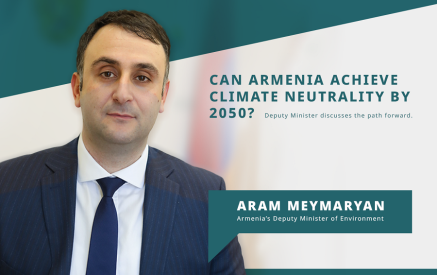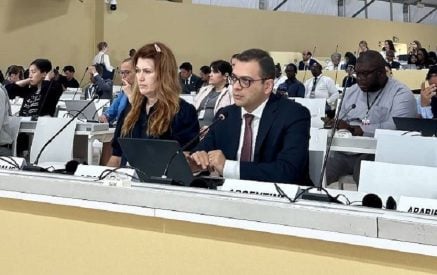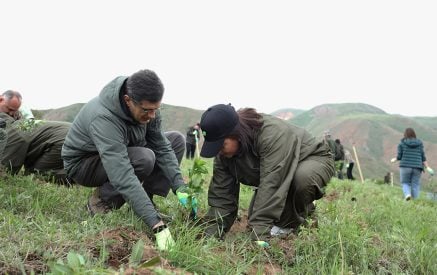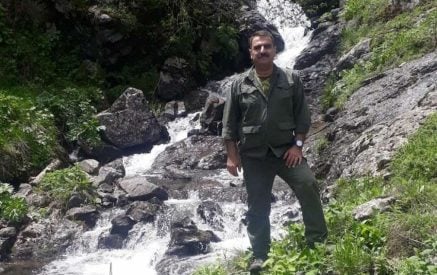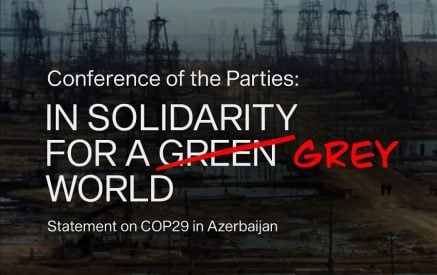Whose Order is the Ministry of Nature Protection Executing with its Lies?
Recently, the media published Meghri city council’s appeal to RA President Serzh Sargsyan. The appeal states, in particular, that the exploitation of metal mines has already caused a disastrous situation in the region. However, licenses have been given for 14 new mines to be explored and exploited. “The map of Armenia’s mineral fields and districts containing uranium deposits” was attached to the appeal to also show the presence of dispersed uranium in the region.
It is surprising that the Head of the staff of the Ministry of Nature Protection answered the appeal addressed to the RA President. He boldly writes: “In the appeal addressed to the President, the mines at Lijk, Tashtun and Lijkavaz-Tei, presented as areas/objects with higher concentration (amount) of uranium and thorium”, as well as the submitted “Map of Armenia’s mineral fields and districts containing uranium deposits”, do not correspond to reality”, and, at the same time he is listing the new mines that are going to be exploited in the region of Meghri.
In addition to driving the people of Meghri into despair with the reply, the Ministry of Nature Protection actually denies the presence of uranium and thorium in the Republic of Armenia despite the numerous facts proving the common occurrence of uranium and thorium in the country.
Read also
During the Soviet years, Armenia was considered to be a promising resource for radioactive materials. That is why the specialized expeditions of Mingeo, Gromov (1948) and Koltsov (1965-1975), took place in Armenia. Armenian scientists and experts in different fields also participated in the search for uranium and other radioactive elements.
In his book “The Uranium Resource of Geological Formations of Armenia” (Yerevan 2010), Doctor of Geological Sciences P.G. Aloyan writes that in his work he has used chiefly the pubished archival materials by A.E. Kocharyan, B.I. Pigulski, V.V.Shelkhovski, M.D. Zagaynov, A.P. Panchenko, V. A. Markovkich, M. A. Yengoyan, L.S. Ruditska, G.Y. Kochinyan, A.M. Antroptsev, E.L. Sarukhanyan, I.B. Kharatova, G.K. Petoyan, B.K. Arkhipov.
Uranium Deposits
Here are some excerpts from Doctor P.G. Aloyan’s book:
“According to geological explorations, in the territory of Armenia, we can conditionally outline four big regions, which have a prospect for radioactive elements: 1. Syunik (in the deep fault of Zangezur, in the watersheds of Vorotan-Voghji-Araks rivers); 2. Vanadzor-Dilijan (in the Sevan-Shirak deep fault); 3. Arzakan-Paraqar (in the territory north-east of the river Hrazdan); 4. Vedi-Vayk (within the left bank of the AraksRiver and beneath the midflow segment of the ArpaRiver). Besides these, there are also small zones in Shamlugh and Jermuk” (Aloyan, pg. 13-14).
“The Pkhrut occurrence/outcropping lies 5-6 kilometers east of Kajaran Copper Molybdenum mine, in the north-eastern zone of Meghri’s magma body (pluton), inside the canyon slopes of the VoghjiRiver. Voghji, Lernadzor, Pkhrut sites were explored. At these sites, at a depth of more than 300 meters, more than 20 uranium-molybdenum mineral bodies were discovered (with an average uranium concentration of 0.2%) (pg. 20-21). The First mineral body, out of the 22 mineral bodies found in the Andian occurrence, adjacent to the mineral field of Pkhrut-Lernadzor, was relatively thoroughly explored: its average uranium concentration – 0.2-0.3%. 2.5 tons of uranium was extracted from that First mineral body, in 1968” (pg. 22-23).
“The Kayategh site (Vayq city, on the right bank of the river Arpa, average uranium concentration 0.06%) and the Atdar site are two of the several uranium-gold-multi-metallic outcroppings/occurrences ….” (pg. 29).
“One of the uranium-molybdenum outcroppings/occurrences is at Antarrayin site (15km from Hrazdan city, on the left bank of AghveranRiver; uranium concentration – 0.03-0.14%)…. One of the uranium-thorium- rare-earth outcroppings/occurrences is at Tezhsar site (Pambak mountain range), situated at the upper reaches of the river Ulyashik (uranium concentration can be as high as 0.086%)” (pg. 30-33).
“New samples and the results of special metallurgical tests, together with literature and archival materials, give us grounds to consider the Meghri fault …., together with the underlying deep magma body (pluton) granitoids as a prospective large mine having gold-uranium-rare metals mineralization” (pg. 65).
“The processing of mineral ores containing 0.05-0.07 % uranium oxide is currently considered to be economically expedient. During the Soviet period, ores containing 0.012-0.2% uranium were processed, which can be a good orientation for a country such as Armenia” (pg. 126).
“The actual material indicates that in the coming years, in the Republic, it will be possible to create a mineral-derived-fuel stock for nuclear energy, which will ensure the development of that energy sphere in the future. In that case, it is necessary to segregate the mineral fields, mines and those sites, which are prospective in terms of radioactive materials. According to the current results of exploration, the most prospective deposits for Armenia are those of uranium-molybdenum, uranium-gold-polymetal, uranium-arsenic and the ore fields with rare-earth mineralization of uraninite – fluorite – biotite type. The content of uranium varies widely, the average is 0.2-0.5%.
The most prospective mines are the Kajaran copper-molybdenum mine, the Azatek gold-polymetallic (gold- antimony-arsenic) mine and the mineral field of Marmarik river’s drainage basin. There are some prospects on the molybdenum-uranium sub-formation of Pekhrut and And mines, which are located within the wings of the Kajaran Copper Molybdenum mine and are connected through Lerrnadzor’s deep fracture to areas along the contacts with Meghri’s deep magma body.
Of industrial interest are Tezjasar and Antarrayin uranium-rare -earth occurrences of Pambak group, which are located in the zone of Marmarik’s fracture, stretching between the blocks of Pambak and Tsaghkunyac mountain ranges, and the utilization of these will secure the rapidly developing mining infrastructures of the Marmarik river basin, taking into account the large reserves of auriferous, cooper-molybdenum and gold-iron and titanomagnetite ores. Gold and uranium are more often found in a finely dispersed state and are often intertwined with pyrite and rarely with tachylite, which makes the ore difficult to process and as a result, they are difficult to detect and difficult to retrieve by using ordinary methods” (pg. 157-165).
We can learn about the prognostic reserves of uranium in Armenia from another work by the same author. For example, Pekhrut site contains 20 thousand tons, Vayk – 20-30 thousand tons, Vedi – 10-15 thousnad tons, Antarrayin – 30-40 thousand tons … (Aloyan G.P., The Resource Potential of Radioactive Materials in Armenia and the Prospects of Its Development, Mining Journal, 2007, N 635).
In his book “The Paths and Prospects of Development of Mining and Metallurgical Industry in RA” (Yerevan, “Science”, 2011, p.260), Professor H.S. Avagyan writes, that according to the data from 40 samples of Amulsar ore, there are 195 tons of uranium at that site alone.
In connection with the dispersed uranium and the presence of uranium occurrences in RA, I will cite an extract from a research work carried out recently: “Uranium deposits extend across the southern slopes of Piramsaryan ridge, about 700 meters long, which is a large aperture. Uranium mineralization in quartzite has a dispersed nature” (Yerevan State University Scientific Journal, 2010, N 3, pp. 18-24).
In addition to the above mentioned, the information denying the existence of uranium in Armenia spread by the Ministry of Nature Protection is also obviously refuted by the fact that in 2007, the governments of the Republic of Armenia and the Russian Federation signed an agreement on joint exploration and exploitation of uranium and thorium deposits. In the plan called “Implementation of geological exploration of uranium and associated minerals in the region of Syunik for 2009-2012” (henceforth – the Plan) prepared by the purposefully created “Armenian-Russian mining organization”, it is written that in 2008, the Russian State Atomic Energy Corporation “Rosatom”, the Russian Federation and the Ministry of Nature Protection of Armenia signed a memorandum on the cooperation in the field of geological exploration, mining and processing of uranium ores.
On page 17 of the same Plan, one reads: “On the peripheral parts of Tashtun fault, there are concentrations of tabular bodies (Dikes), haplite and pegmatite veins, which are characterized by high radioactivity (up to 800 micro R/hr) due to the mineral content of uranium and thorium”. And on pages 18-19, it is written: “The north-western fractures are mainly developed in the western and eastern sides of the square, where they form the network of Tashtun, Kirs and Lernadzor faults. The Tashtun fault is the main structure of the district, it separates the second-rank blocks and controls the location of all poly-metal, copper, molybdenum (including uranium) main mines and occurrences/outcroppings”.
It shows itself continually – from the southern borders of Meghri’s deep magma body (pluton) to the Geghi river outfall…. The Tashtun fault is a layer of 100 m – 2 km in width which consists of a system of closely spaced tectonic rifts and zones of crushed, creased and cracked rocks which are mostly intensively hydrothermally modified by sulfidic and by quartz and carbon veins, which rarely carry uranium mineralization. The most dominant mineralization in the mining area of Zangezur is that of copper-molydenum… According to the frequency of occurrences uranium mineralization occupies the second place”.
Conclusion
The above mentioned excerpts from professional literature, as well as the Russian-Armenian agreement on joint exploration and exploitation of uranium and thorium deposits and the Plan show that the dispersed uranium and its mineralization in RA occupy a large area, and “The map of Armenia’s mineral fields and districts containing uranium deposits” absolutely corresponds to reality.
It is quite clear that covering up the presence of dispersed uranium, which has an industrial prospect, has a particular purpose. By saying dispersed uranium, we mean very low concentrations of uranium accompanying the useful elements in different deposits, and this makes its extraction very difficult and therefore much of the uranium will remain in the tailings (mining waste dumps). Consequently, the exploitation of the deposits of dispersed uranium within such a small territory, such as the country of Armenia, is simply a crime. I am sure that the mining industry knows that very well. The concealment of the existence of dispersed uranium gives an opportunity to exploit the uranium deposits without scandals and obstacles, and this means large-scale poisoning of the territory of RA, and eventually, destruction of life support for the people of Armenia.
Unfortunately, there is nothing to be optimistic about, on the contrary, in the Armenian-Russian Plan mentioned above, it is said that by using modern methods, reinterpretation of the results of the previous years’ work, will allow to mine numerous uranium mineralizing zones which have no industrial value, as well as geochemical anomalies, which are represented as having no prospects because of their deep location (pg. 11). Thus, we may conclude that the deposits, whose exploitation was considered impermissible in the Soviet period, can be exploited if, certainly, the people of Armenia do not wake up and come to their senses.
Today, it has become almost impossible to negotiate with the mining cabal and to prevent its lethal plans from being realized. This cabal is supported not only by the Ministry of Nature Protection, but also by all government bureaucracies and the media, which is controlled by it. A most recent example is the completely illegal (without any permits) construction of an ore processing plant next to Tashtun village, in Meghri region, by AT-Metals mining company, which is conducting mineral exploration in that region, close-by, at Karasar and Meghrasar (Prichrebtovoye). The company has been carrying out plant construction for the past 4 months, utilizing the lands belonging to Tashtun village, before the exploration work is completed, before the mineral reserves of gold, silver, etc. are confirmed/ inspected and registered by government bodies, before a mine exploitation plan is submitted to government ministries for approval, for the purpose of obtaining a license to mine. And yet, already much of the arable productive lands of Tashtun village has been ruined, and construction waste has been dumped into the mountain stream of Tashtun….
The policy implemented in the field of mining in RA is imported. The exclusion of mining wastes from the taxation field, the exemption of mine owners from compensating the damage caused to the economy, and many other privileges enjoyed by mining companies, all derive from the international meddling in our country’s legislative field, creating confusion and disarray in RA laws.
In conclusion, I would like to say that in spite of the prevalence of uranium, the Republic of Armenia has very favorable conditions for supporting life: the chemically bound uranium hidden in solid bodies is not a threat to life, but it is a different matter when those solid bodies, ores, are extracted from the earth and pulverized into fine particles.
August 2013
Hakob Sanasaryan
Chairman of the Green Union of Armenia























































